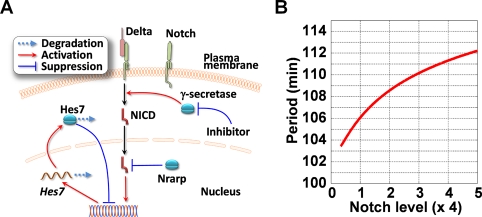FIGURE 6:
Mathematical analyses of the effect of Notch activity on the oscillation period. (A) The molecular mechanism of generation of oscillatory gene expression in the mouse PSM cell. Activated Notch receives limited proteolysis, which is dependent on γ-secretase activity, and then NICD activates Hes7 transcription. The accumulated Hes7 protein inhibits its own transcription. This negative feedback loop serves as a core mechanism of gene oscillation in the mouse PSM. Nrarp enhances the degradation of NICD, thereby inhibiting Notch activity, and the γ-secretase inhibitor reduces the production of NICD to inhibit Notch activity. In this research, we increased Notch activity by disrupting Nrarp and decreased it by administration of the γ-secretase inhibitor. (B) Dependence of the oscillation period on Notch activity. The mathematical model based on the negative feedback loop of Hes7 shown in (A) was used for the mathematical simulation. The oscillation period has a positive relationship with the average Notch activity, which is described as the maximum rate of Hes7 mRNA production, k (see Supplemental Note 1). Model parameters are listed in Supplemental Note 1.

